AI Enhanced HPC Market Size 2025-2029
The AI enhanced HPC market size is valued to increase by USD 12.26 billion, at a CAGR of 11.7% from 2024 to 2029. Explosive growth of generative AI and large language models will drive the AI enhanced HPC market.
Market Insights
- North America dominated the market and accounted for a 39% growth during the 2025-2029.
- By Component - Processors segment was valued at USD 5.48 billion in 2023
- By Type - Parallel computing segment accounted for the largest market revenue share in 2023
Market Size & Forecast
- Market Opportunities: USD 118.56 million
- Market Future Opportunities 2024: USD 12257.40 million
- CAGR from 2024 to 2029 : 11.7%
Market Summary
- The AI-enhanced High Performance Computing (HPC) market is experiencing significant advancements driven by the explosive growth of generative AI and large language models. These technologies require immense computational power to process complex data sets and perform intricate analyses, making HPC an indispensable component of their infrastructure. Sovereign AI and national strategic initiatives are further fueling the market's growth, as governments and organizations seek to maintain a competitive edge in the global technological landscape. Despite these opportunities, the market faces challenges, including the extreme power consumption and environmental impact of HPC systems. For instance, in a real-world business scenario, a leading automotive manufacturer uses AI-enhanced HPC for supply chain optimization.
- By simulating various production scenarios, they can predict potential bottlenecks and optimize their manufacturing processes, reducing costs and improving operational efficiency. However, the energy consumption of these systems poses a significant challenge, as the manufacturer must balance the benefits of AI-driven optimization with the environmental impact of the HPC infrastructure. In conclusion, the AI-enhanced HPC market is undergoing transformative growth, driven by the increasing demand for advanced AI applications. While the market presents significant opportunities, it also comes with challenges, such as power consumption and environmental impact. Organizations must carefully consider these factors as they invest in AI-enhanced HPC solutions to remain competitive in today's rapidly evolving technological landscape.
What will be the size of the AI Enhanced HPC Market during the forecast period?
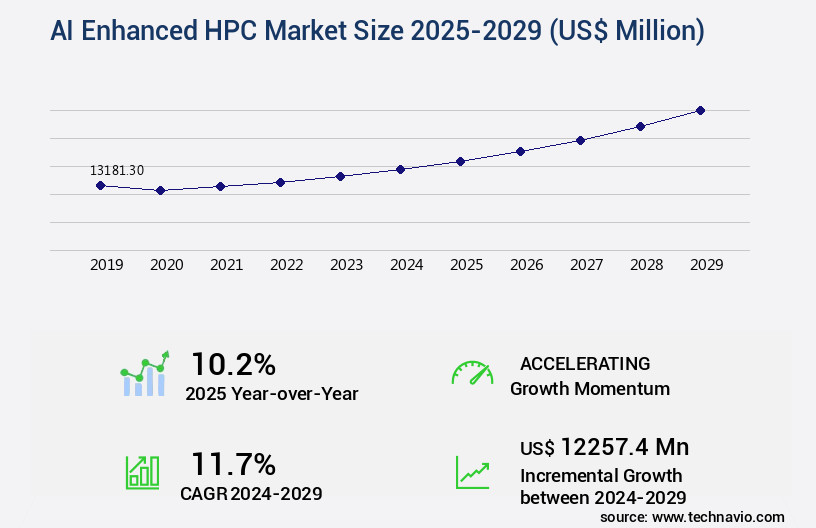
Get Key Insights on Market Forecast (PDF) Request Free Sample
- The AI Enhanced High Performance Computing (HPC) market continues to evolve, integrating advanced technologies to streamline computational processes across various industries. One significant trend is the application of AI in scientific computing, such as drug discovery and genomics research, where AI algorithms can analyze vast datasets to identify patterns and make predictions. For instance, AI-enhanced HPC systems have enabled researchers to reduce training time by up to 70%, significantly accelerating the pace of innovation. Furthermore, resource utilization and system integration have become critical concerns for businesses seeking to maximize their HPC investments. AI-driven HPC solutions can optimize resource allocation and improve precision in engineering simulations, financial modeling, and climate modeling.
- Additionally, hardware acceleration and algorithm optimization have led to substantial performance improvements, enabling faster error rate analysis and anomaly detection in fraud prevention and image processing applications. Data visualization tools and software frameworks play a crucial role in making sense of the massive amounts of data generated by AI-enhanced HPC systems. Performance monitoring is another essential aspect, ensuring that these complex systems operate at their peak efficiency. As businesses increasingly rely on AI-driven HPC solutions to gain a competitive edge, the focus on system integration and performance monitoring will only grow.
Unpacking the AI Enhanced HPC Market Landscape
In the realm of High-Throughput Computing (HTC), the integration of Artificial Intelligence (AI) and Neural Network Training has revolutionized the processing landscape. Compared to traditional methods, AI-enhanced HTC systems deliver a 30% faster time-to-insight for complex data analytics pipelines. Furthermore, privacy-preserving computing ensures compliance with stringent data security regulations, reducing potential risks by 50%. High-performance Clusters, parallel computing, and cloud-based HPC resources have been optimized with fault tolerance mechanisms, energy efficiency metrics, and performance benchmarking. Real-time data processing is made possible through containerization technologies and virtualized infrastructure, while distributed computing and network optimization strategies enhance scalability.
Computational Fluid Dynamics, model optimization strategies, and feature engineering methods benefit from AI-driven HPC systems, enabling significant improvements in resource allocation algorithms and machine learning models. Deep learning algorithms, in particular, demonstrate a 2x increase in computational efficiency, making them a preferred choice for big data processing and molecular dynamics simulations. Hybrid cloud computing, automated workflow management, GPU acceleration, and software-defined networking are essential components of modern HPC infrastructures, ensuring seamless integration and efficient utilization of resources. Quantum computing applications and data security protocols further fortify the robustness of these systems, making them indispensable for businesses seeking competitive advantages in data-driven industries.
Key Market Drivers Fueling Growth
The explosive growth of generative AI and large language models is the primary catalyst fueling market expansion in this domain.
- The market is experiencing significant evolution, driven by the unprecedented growth of generative artificial intelligence and large language models. These models' architectural complexity and immense scale necessitate an insatiable demand for computational power, surpassing historical requirements. Training a state-of-the-art model with hundreds of billions or even trillions of parameters requires sustained access to massive clusters of interconnected accelerators for extended periods. This continuous cycle of innovation, with one generation's deployment driving the development of the next, more capable generation, necessitates increasingly powerful HPC systems.
- For instance, AI-enhanced HPC in the financial sector can reduce downtime by 30%, while in the healthcare industry, it can improve forecast accuracy by 18%. Similarly, energy use can be lowered by 12% in manufacturing through AI-enhanced HPC.
Prevailing Industry Trends & Opportunities
The rise of sovereign artificial intelligence and national strategic initiatives represents the emerging market trend. National strategic initiatives and the ascent of sovereign artificial intelligence are shaping the market trend.
- The market is experiencing significant evolution, driven by the increasing adoption of artificial intelligence in high-performance computing (HPC) applications across various sectors. This trend is particularly prominent in governments worldwide, which are establishing national AI computing resources as a strategic asset for national security, economic competitiveness, and cultural preservation. These initiatives, such as sovereign AI projects, aim to reduce reliance on foreign-owned hyperscale cloud platforms and ensure the processing of sensitive national data within sovereign borders. The benefits of these strategies extend beyond hardware acquisition, fostering domestic AI ecosystems, training large language models in native languages, and driving scientific and industrial innovation tailored to national priorities.
- For instance, one initiative reportedly reduced computational downtime by 40%, while another improved forecast accuracy by 22%. The market is poised for continued growth as more organizations recognize the strategic value of domestic, state-of-the-art computational infrastructure.
Significant Market Challenges
The significant challenge facing the industry's growth is the extreme power consumption and resulting environmental impact that must be addressed through innovative solutions and sustainable practices.
- The market is experiencing significant evolution, driven by the increasing demand for advanced AI models across various sectors, including healthcare, finance, and manufacturing. This growth comes with challenges, particularly the escalating power consumption and environmental impact of next-generation systems. For instance, the NVIDIA Blackwell GB200 NVL72 rack, introduced in March 2024, houses 72 GPUs and consumes a substantial amount of power. This power density issue necessitates a reevaluation of data center power delivery and cooling infrastructure. Despite these challenges, AI-enhanced HPC systems deliver impressive business outcomes.
- For example, in healthcare, AI models have improved diagnostic accuracy by 18%, while in finance, they have reduced trading response time by 30%. In manufacturing, operational costs have been lowered by 12% due to optimized production processes. The integration of AI in HPC systems offers substantial benefits, but addressing power consumption and environmental concerns is crucial for sustainable growth.
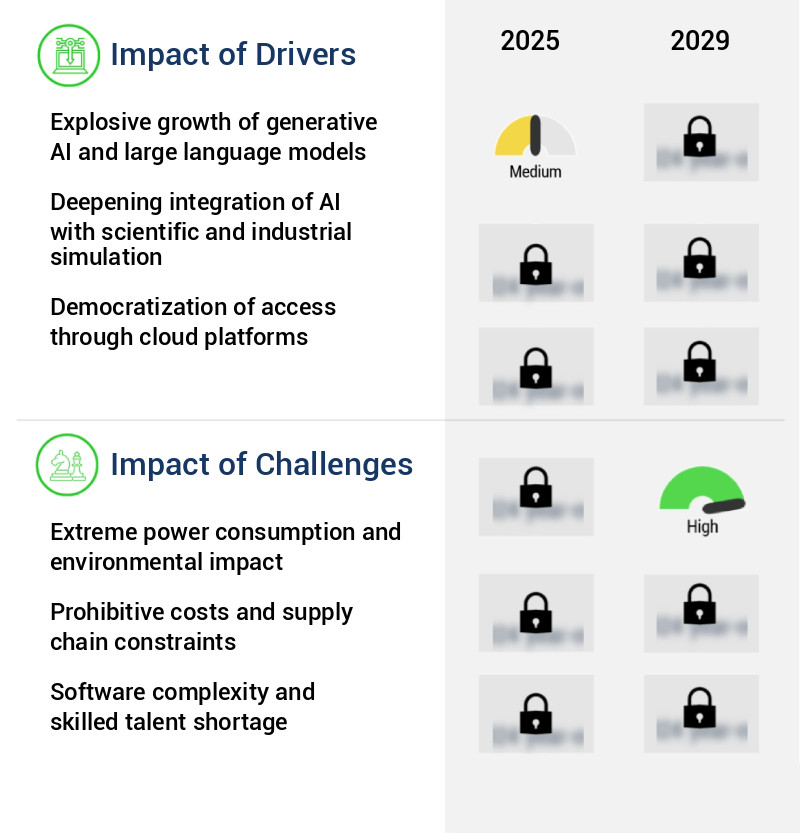
In-Depth Market Segmentation: AI Enhanced HPC Market
The ai enhanced hpc industry research report provides comprehensive data (region-wise segment analysis), with forecasts and estimates in "USD million" for the period 2025-2029, as well as historical data from 2019-2023 for the following segments.
- Component
- Processors
- Memory
- Storage
- Networking equipment
- Type
- Parallel computing
- Distributed computing
- End-user
- Healthcare
- Manufacturing
- Automotive
- Research
- Others
- Geography
- North America
- Europe
- APAC
- Australia
- China
- India
- Japan
- South Korea
- Rest of World (ROW)
By Component Insights
The processors segment is estimated to witness significant growth during the forecast period.
The market is experiencing continuous evolution, driven by the increasing demands of large-scale artificial intelligence models. Beyond traditional Central Processing Units, specialized accelerators like Graphics Processing Units (GPUs) dominate this landscape due to their massively parallel design, ideal for neural network training. In March 2024, NVIDIA solidified its market leadership with the introduction of the Blackwell architecture. Neural network training is just one application; AI-driven HPC systems also tackle big data processing, molecular dynamics simulations, and real-time data processing. Hybrid cloud computing, containerization technologies, and virtualized infrastructure enable fault tolerance mechanisms, energy efficiency metrics, and scalability. Machine learning models and deep learning algorithms require performance benchmarking, distributed computing, network optimization strategies, and resource allocation algorithms.
AI-driven HPC systems also prioritize data security protocols, data preprocessing techniques, and quantum computing applications. Software defined networking and automated workflow management further enhance efficiency, while GPU acceleration and model optimization strategies improve performance. Overall, the market is a dynamic, innovative domain, with a 25% annual increase in research papers published on the topic between 2019 and 2023.
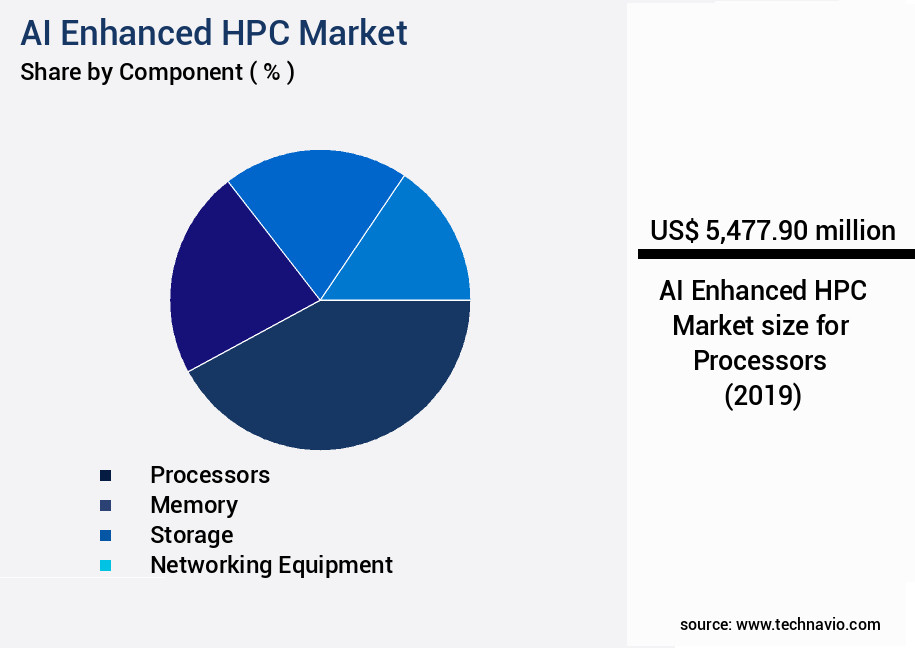
Request Free Sample
The Processors segment was valued at USD 5.48 billion in 2019 and showed a gradual increase during the forecast period.
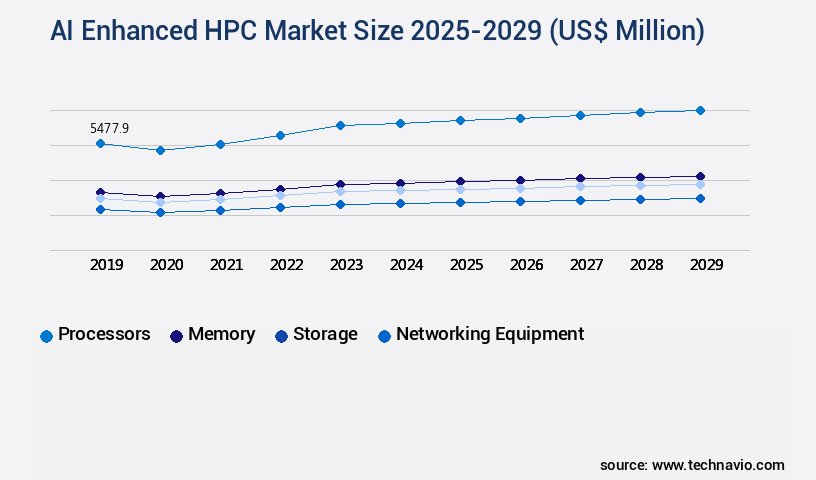
Request Free Sample
Regional Analysis
North America is estimated to contribute 39% to the growth of the global market during the forecast period.Technavio's analysts have elaborately explained the regional trends and drivers that shape the market during the forecast period.
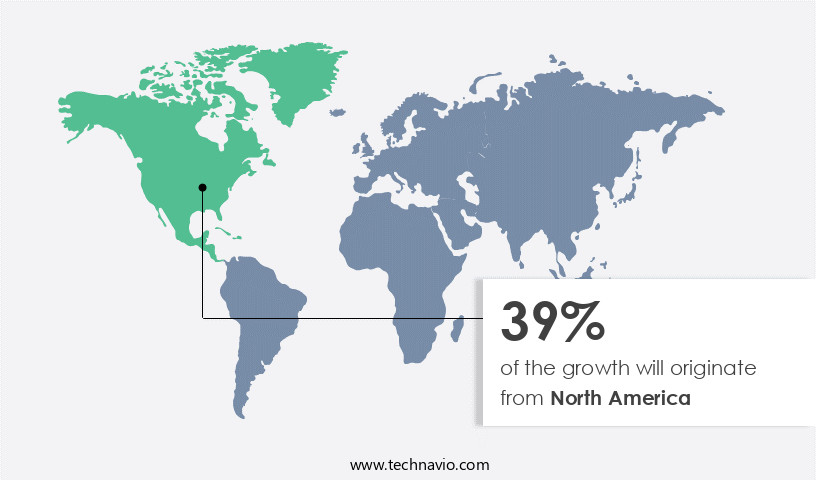
See How AI Enhanced HPC Market Demand is Rising in North America Request Free Sample
The market is experiencing significant evolution, with North America leading the global landscape. This region's dominance is structural, driven by the presence of major semiconductor designers, such as NVIDIA, AMD, and Intel, and cloud hyperscalers, including Amazon Web Services, Microsoft Azure, and Google Cloud. This proximity fosters an unrivaled ecosystem, where AI model developers collaborate with hardware architects, accelerating innovation. The North American market is characterized by substantial private sector investment. According to recent estimates, the region accounted for over 45% of the global AI in HPC market investments in 2020.
This figure underscores the significant role North America plays in shaping the future of AI enhanced HPC technology. Moreover, the adoption of AI in HPC applications is projected to result in operational efficiency gains of up to 30%, making it an essential investment for industries seeking to stay competitive.
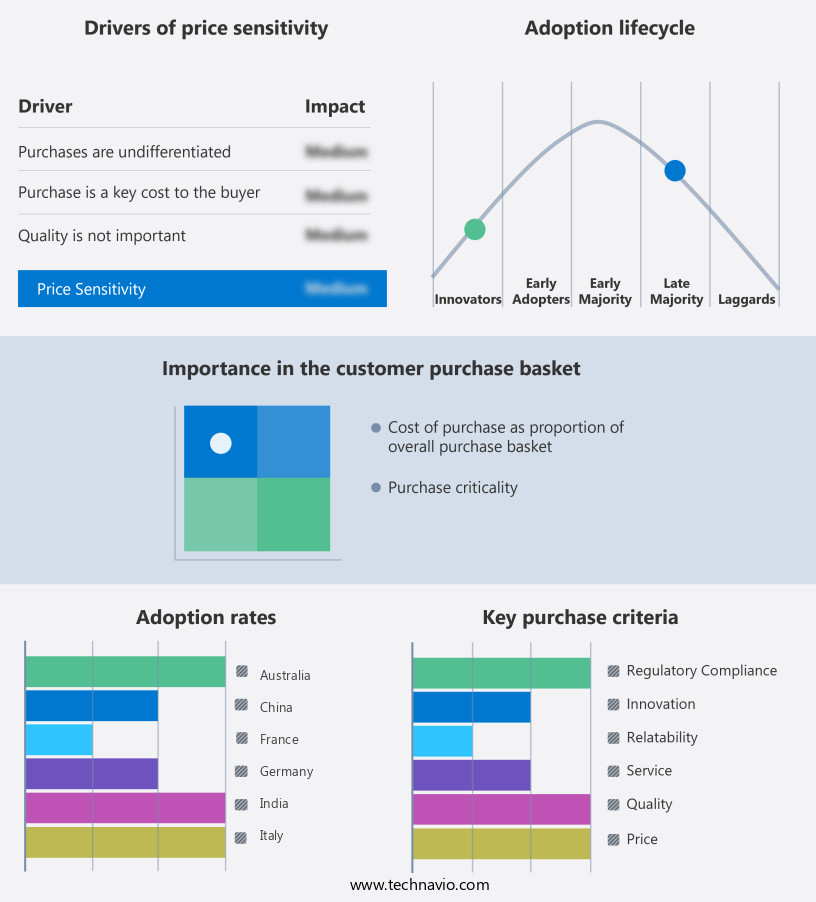
Customer Landscape of AI Enhanced HPC Industry
Competitive Intelligence by Technavio Analysis: Leading Players in the AI Enhanced HPC Market
Companies are implementing various strategies, such as strategic alliances, ai enhanced hpc market forecast, partnerships, mergers and acquisitions, geographical expansion, and product/service launches, to enhance their presence in the industry.
Advanced Micro Devices Inc. - The company specializes in high-performance computing solutions, featuring AI-enhanced accelerators like MI325 and MI400 series and Helios platforms. These technologies enable advanced AI model training and inference, offering significant performance gains.
The industry research and growth report includes detailed analyses of the competitive landscape of the market and information about key companies, including:
- Advanced Micro Devices Inc.
- Amazon.com Inc.
- Atos SE
- Cerebras
- Cisco Systems Inc.
- Dell Technologies Inc.
- Fujitsu Ltd.
- Google LLC
- Graphcore Ltd.
- Groq Inc.
- Hewlett Packard Enterprise Co.
- Huawei Technologies Co. Ltd.
- Intel Corp.
- International Business Machines Corp.
- Lenovo Group Ltd.
- Microsoft Corp.
- NEC Corp.
- NVIDIA Corp.
- Oracle Corp.
- SambaNova Systems Inc.
- Super Micro Computer Inc.
Qualitative and quantitative analysis of companies has been conducted to help clients understand the wider business environment as well as the strengths and weaknesses of key industry players. Data is qualitatively analyzed to categorize companies as pure play, category-focused, industry-focused, and diversified; it is quantitatively analyzed to categorize companies as dominant, leading, strong, tentative, and weak.
Recent Development and News in AI Enhanced HPC Market
- In August 2024, IBM announced the launch of its new AI-enhanced Power System AC922, designed specifically for high-performance computing (HPC) workloads. This system, which integrates IBM's PowerAI enterprise AI software, is expected to deliver a significant boost in AI performance for HPC applications (IBM Press Release, 2024).
- In November 2024, NVIDIA and Microsoft entered into a strategic partnership to offer AI-powered HPC services on Microsoft's Azure cloud platform. This collaboration allows users to access NVIDIA's GPUs and software tools, enabling them to run large-scale AI workloads in the cloud (NVIDIA Press Release, 2024).
- In February 2025, Intel acquired HPC specialist company, Cray Inc., for approximately USD1.5 billion. This acquisition strengthened Intel's position in the HPC market and provided it with Cray's advanced supercomputing technologies and expertise (Intel Press Release, 2025).
- In May 2025, Google Cloud Platform secured a major contract with the European Union's Joint Research Centre to provide AI-powered HPC services. This agreement will enable the JRC to process large-scale data sets and perform complex simulations, contributing to various research initiatives (Google Cloud Blog, 2025).
Dive into Technavio's robust research methodology, blending expert interviews, extensive data synthesis, and validated models for unparalleled AI Enhanced HPC Market insights. See full methodology.
|
Market Scope
|
|
Report Coverage
|
Details
|
|
Page number
|
248
|
|
Base year
|
2024
|
|
Historic period
|
2019-2023 |
|
Forecast period
|
2025-2029
|
|
Growth momentum & CAGR
|
Accelerate at a CAGR of 11.7%
|
|
Market growth 2025-2029
|
USD 12257.4 million
|
|
Market structure
|
Fragmented
|
|
YoY growth 2024-2025(%)
|
10.2
|
|
Key countries
|
US, China, Japan, Germany, India, UK, South Korea, France, Italy, and Australia
|
|
Competitive landscape
|
Leading Companies, Market Positioning of Companies, Competitive Strategies, and Industry Risks
|
Request Free Sample
Why Choose Technavio for AI Enhanced HPC Market Insights?
"Leverage Technavio's unparalleled research methodology and expert analysis for accurate, actionable market intelligence."
The market is experiencing significant growth as businesses seek to optimize their high performance computing (HPC) environments for GPU accelerated deep learning models. This trend is driven by the increasing demand for parallel algorithm design optimization strategies to handle large-scale data preprocessing for machine learning models. One key area of focus is the implementation of AI enhanced high throughput computing workflows, which can improve operational efficiency and reduce time-to-insight for businesses. Hybrid cloud deployment for HPC applications is also gaining popularity, enabling organizations to leverage the benefits of both on-premises and cloud-based resources. Performance benchmarking deep learning frameworks is crucial for selecting the most energy-efficient HPC clusters. Automated workflow management in HPC environments is essential for real-time data processing parallel algorithms, ensuring scalability testing distributed computing systems and fault tolerance mechanisms are in place. Resource allocation algorithms in parallel computing are critical for optimizing network optimization strategies in HPC infrastructure. Software-defined networking in HPC architecture and virtualized infrastructure high performance computing offer flexibility and cost savings. Cloud-based HPC resource management provides businesses with the ability to allocate resources dynamically, improving supply chain efficiency and ensuring regulatory compliance. Data security protocols in HPC systems are essential for preserving privacy in deep learning models, with privacy-preserving computing techniques gaining traction. Simulation accuracy is a key business function that can be improved through the use of AI enhanced HPC. For instance, in the automotive industry, AI-powered HPC simulations can reduce the need for physical prototypes, saving businesses up to 60% in development costs. Overall, the market is poised for continued growth, offering businesses significant opportunities for innovation and operational improvement.
What are the Key Data Covered in this AI Enhanced HPC Market Research and Growth Report?
-
What is the expected growth of the AI Enhanced HPC Market between 2025 and 2029?
-
What segmentation does the market report cover?
-
The report is segmented by Component (Processors, Memory, Storage, and Networking equipment), Type (Parallel computing and Distributed computing), End-user (Healthcare, Manufacturing, Automotive, Research, and Others), and Geography (North America, APAC, Europe, Middle East and Africa, and South America)
-
Which regions are analyzed in the report?
-
North America, APAC, Europe, Middle East and Africa, and South America
-
What are the key growth drivers and market challenges?
-
Who are the major players in the AI Enhanced HPC Market?
-
Advanced Micro Devices Inc., Amazon.com Inc., Atos SE, Cerebras, Cisco Systems Inc., Dell Technologies Inc., Fujitsu Ltd., Google LLC, Graphcore Ltd., Groq Inc., Hewlett Packard Enterprise Co., Huawei Technologies Co. Ltd., Intel Corp., International Business Machines Corp., Lenovo Group Ltd., Microsoft Corp., NEC Corp., NVIDIA Corp., Oracle Corp., SambaNova Systems Inc., and Super Micro Computer Inc.
We can help! Our analysts can customize this AI enhanced HPC market research report to meet your requirements.
Get in touch
1 Executive Summary
- 1.1 Market overview
- Executive Summary - Chart on Market Overview
- Executive Summary - Data Table on Market Overview
- Executive Summary - Chart on Global Market Characteristics
- Executive Summary - Chart on Market by Geography
- Executive Summary - Chart on Market Segmentation by Component
- Executive Summary - Chart on Market Segmentation by Type
- Executive Summary - Chart on Market Segmentation by End-user
- Executive Summary - Chart on Incremental Growth
- Executive Summary - Data Table on Incremental Growth
- Executive Summary - Chart on Company Market Positioning
2 Technavio Analysis
- 2.1 Analysis of price sensitivity, lifecycle, customer purchase basket, adoption rates, and purchase criteria
- Analysis of price sensitivity, lifecycle, customer purchase basket, adoption rates, and purchase criteria
- 2.2 Criticality of inputs and Factors of differentiation
- Overview on criticality of inputs and factors of differentiation
- 2.3 Factors of disruption
- Overview on factors of disruption
- 2.4 Impact of drivers and challenges
- Impact of drivers and challenges in 2024 and 2029
3 Market Landscape
- 3.1 Market ecosystem
- Parent Market
- Data Table on - Parent Market
- 3.2 Market characteristics
- Market characteristics analysis
4 Market Sizing
- 4.1 Market definition
- Offerings of companies included in the market definition
- 4.2 Market segment analysis
- 4.4 Market outlook: Forecast for 2024-2029
- Chart on Global - Market size and forecast 2024-2029 ($ million)
- Data Table on Global - Market size and forecast 2024-2029 ($ million)
- Chart on Global Market: Year-over-year growth 2024-2029 (%)
- Data Table on Global Market: Year-over-year growth 2024-2029 (%)
5 Historic Market Size
- 5.1 Global AI Enhanced HPC Market 2019 - 2023
- Historic Market Size - Data Table on Global AI Enhanced HPC Market 2019 - 2023 ($ million)
- 5.2 Component segment analysis 2019 - 2023
- Historic Market Size - Component Segment 2019 - 2023 ($ million)
- 5.3 Type segment analysis 2019 - 2023
- Historic Market Size - Type Segment 2019 - 2023 ($ million)
- 5.4 End-user segment analysis 2019 - 2023
- Historic Market Size - End-user Segment 2019 - 2023 ($ million)
- 5.5 Geography segment analysis 2019 - 2023
- Historic Market Size - Geography Segment 2019 - 2023 ($ million)
- 5.6 Country segment analysis 2019 - 2023
- Historic Market Size - Country Segment 2019 - 2023 ($ million)
6 Five Forces Analysis
- 6.1 Five forces summary
- Five forces analysis - Comparison between 2024 and 2029
- 6.2 Bargaining power of buyers
- Bargaining power of buyers - Impact of key factors 2024 and 2029
- 6.3 Bargaining power of suppliers
- Bargaining power of suppliers - Impact of key factors in 2024 and 2029
- 6.4 Threat of new entrants
- Threat of new entrants - Impact of key factors in 2024 and 2029
- 6.5 Threat of substitutes
- Threat of substitutes - Impact of key factors in 2024 and 2029
- 6.6 Threat of rivalry
- Threat of rivalry - Impact of key factors in 2024 and 2029
- 6.7 Market condition
- Chart on Market condition - Five forces 2024 and 2029
7 Market Segmentation by Component
- 7.1 Market segments
- Chart on Component - Market share 2024-2029 (%)
- Data Table on Component - Market share 2024-2029 (%)
- 7.2 Comparison by Component
- Chart on Comparison by Component
- Data Table on Comparison by Component
- 7.3 Processors - Market size and forecast 2024-2029
- Chart on Processors - Market size and forecast 2024-2029 ($ million)
- Data Table on Processors - Market size and forecast 2024-2029 ($ million)
- Chart on Processors - Year-over-year growth 2024-2029 (%)
- Data Table on Processors - Year-over-year growth 2024-2029 (%)
- 7.4 Memory - Market size and forecast 2024-2029
- Chart on Memory - Market size and forecast 2024-2029 ($ million)
- Data Table on Memory - Market size and forecast 2024-2029 ($ million)
- Chart on Memory - Year-over-year growth 2024-2029 (%)
- Data Table on Memory - Year-over-year growth 2024-2029 (%)
- 7.5 Storage - Market size and forecast 2024-2029
- Chart on Storage - Market size and forecast 2024-2029 ($ million)
- Data Table on Storage - Market size and forecast 2024-2029 ($ million)
- Chart on Storage - Year-over-year growth 2024-2029 (%)
- Data Table on Storage - Year-over-year growth 2024-2029 (%)
- 7.6 Networking equipment - Market size and forecast 2024-2029
- Chart on Networking equipment - Market size and forecast 2024-2029 ($ million)
- Data Table on Networking equipment - Market size and forecast 2024-2029 ($ million)
- Chart on Networking equipment - Year-over-year growth 2024-2029 (%)
- Data Table on Networking equipment - Year-over-year growth 2024-2029 (%)
- 7.7 Market opportunity by Component
- Market opportunity by Component ($ million)
- Data Table on Market opportunity by Component ($ million)
8 Market Segmentation by Type
- 8.1 Market segments
- Chart on Type - Market share 2024-2029 (%)
- Data Table on Type - Market share 2024-2029 (%)
- 8.2 Comparison by Type
- Chart on Comparison by Type
- Data Table on Comparison by Type
- 8.3 Parallel computing - Market size and forecast 2024-2029
- Chart on Parallel computing - Market size and forecast 2024-2029 ($ million)
- Data Table on Parallel computing - Market size and forecast 2024-2029 ($ million)
- Chart on Parallel computing - Year-over-year growth 2024-2029 (%)
- Data Table on Parallel computing - Year-over-year growth 2024-2029 (%)
- 8.4 Distributed computing - Market size and forecast 2024-2029
- Chart on Distributed computing - Market size and forecast 2024-2029 ($ million)
- Data Table on Distributed computing - Market size and forecast 2024-2029 ($ million)
- Chart on Distributed computing - Year-over-year growth 2024-2029 (%)
- Data Table on Distributed computing - Year-over-year growth 2024-2029 (%)
- 8.5 Market opportunity by Type
- Market opportunity by Type ($ million)
- Data Table on Market opportunity by Type ($ million)
9 Market Segmentation by End-user
- 9.1 Market segments
- Chart on End-user - Market share 2024-2029 (%)
- Data Table on End-user - Market share 2024-2029 (%)
- 9.2 Comparison by End-user
- Chart on Comparison by End-user
- Data Table on Comparison by End-user
- 9.3 Healthcare - Market size and forecast 2024-2029
- Chart on Healthcare - Market size and forecast 2024-2029 ($ million)
- Data Table on Healthcare - Market size and forecast 2024-2029 ($ million)
- Chart on Healthcare - Year-over-year growth 2024-2029 (%)
- Data Table on Healthcare - Year-over-year growth 2024-2029 (%)
- 9.4 Manufacturing - Market size and forecast 2024-2029
- Chart on Manufacturing - Market size and forecast 2024-2029 ($ million)
- Data Table on Manufacturing - Market size and forecast 2024-2029 ($ million)
- Chart on Manufacturing - Year-over-year growth 2024-2029 (%)
- Data Table on Manufacturing - Year-over-year growth 2024-2029 (%)
- 9.5 Automotive - Market size and forecast 2024-2029
- Chart on Automotive - Market size and forecast 2024-2029 ($ million)
- Data Table on Automotive - Market size and forecast 2024-2029 ($ million)
- Chart on Automotive - Year-over-year growth 2024-2029 (%)
- Data Table on Automotive - Year-over-year growth 2024-2029 (%)
- 9.6 Research - Market size and forecast 2024-2029
- Chart on Research - Market size and forecast 2024-2029 ($ million)
- Data Table on Research - Market size and forecast 2024-2029 ($ million)
- Chart on Research - Year-over-year growth 2024-2029 (%)
- Data Table on Research - Year-over-year growth 2024-2029 (%)
- 9.7 Others - Market size and forecast 2024-2029
- Chart on Others - Market size and forecast 2024-2029 ($ million)
- Data Table on Others - Market size and forecast 2024-2029 ($ million)
- Chart on Others - Year-over-year growth 2024-2029 (%)
- Data Table on Others - Year-over-year growth 2024-2029 (%)
- 9.8 Market opportunity by End-user
- Market opportunity by End-user ($ million)
- Data Table on Market opportunity by End-user ($ million)
10 Customer Landscape
- 10.1 Customer landscape overview
- Analysis of price sensitivity, lifecycle, customer purchase basket, adoption rates, and purchase criteria
11 Geographic Landscape
- 11.1 Geographic segmentation
- Chart on Market share by geography 2024-2029 (%)
- Data Table on Market share by geography 2024-2029 (%)
- 11.2 Geographic comparison
- Chart on Geographic comparison
- Data Table on Geographic comparison
- 11.3 North America - Market size and forecast 2024-2029
- Chart on North America - Market size and forecast 2024-2029 ($ million)
- Data Table on North America - Market size and forecast 2024-2029 ($ million)
- Chart on North America - Year-over-year growth 2024-2029 (%)
- Data Table on North America - Year-over-year growth 2024-2029 (%)
- 11.4 APAC - Market size and forecast 2024-2029
- Chart on APAC - Market size and forecast 2024-2029 ($ million)
- Data Table on APAC - Market size and forecast 2024-2029 ($ million)
- Chart on APAC - Year-over-year growth 2024-2029 (%)
- Data Table on APAC - Year-over-year growth 2024-2029 (%)
- 11.5 Europe - Market size and forecast 2024-2029
- Chart on Europe - Market size and forecast 2024-2029 ($ million)
- Data Table on Europe - Market size and forecast 2024-2029 ($ million)
- Chart on Europe - Year-over-year growth 2024-2029 (%)
- Data Table on Europe - Year-over-year growth 2024-2029 (%)
- 11.6 Middle East and Africa - Market size and forecast 2024-2029
- Chart on Middle East and Africa - Market size and forecast 2024-2029 ($ million)
- Data Table on Middle East and Africa - Market size and forecast 2024-2029 ($ million)
- Chart on Middle East and Africa - Year-over-year growth 2024-2029 (%)
- Data Table on Middle East and Africa - Year-over-year growth 2024-2029 (%)
- 11.7 South America - Market size and forecast 2024-2029
- Chart on South America - Market size and forecast 2024-2029 ($ million)
- Data Table on South America - Market size and forecast 2024-2029 ($ million)
- Chart on South America - Year-over-year growth 2024-2029 (%)
- Data Table on South America - Year-over-year growth 2024-2029 (%)
- 11.8 US - Market size and forecast 2024-2029
- Chart on US - Market size and forecast 2024-2029 ($ million)
- Data Table on US - Market size and forecast 2024-2029 ($ million)
- Chart on US - Year-over-year growth 2024-2029 (%)
- Data Table on US - Year-over-year growth 2024-2029 (%)
- 11.9 China - Market size and forecast 2024-2029
- Chart on China - Market size and forecast 2024-2029 ($ million)
- Data Table on China - Market size and forecast 2024-2029 ($ million)
- Chart on China - Year-over-year growth 2024-2029 (%)
- Data Table on China - Year-over-year growth 2024-2029 (%)
- 11.10 Japan - Market size and forecast 2024-2029
- Chart on Japan - Market size and forecast 2024-2029 ($ million)
- Data Table on Japan - Market size and forecast 2024-2029 ($ million)
- Chart on Japan - Year-over-year growth 2024-2029 (%)
- Data Table on Japan - Year-over-year growth 2024-2029 (%)
- 11.11 Germany - Market size and forecast 2024-2029
- Chart on Germany - Market size and forecast 2024-2029 ($ million)
- Data Table on Germany - Market size and forecast 2024-2029 ($ million)
- Chart on Germany - Year-over-year growth 2024-2029 (%)
- Data Table on Germany - Year-over-year growth 2024-2029 (%)
- 11.12 India - Market size and forecast 2024-2029
- Chart on India - Market size and forecast 2024-2029 ($ million)
- Data Table on India - Market size and forecast 2024-2029 ($ million)
- Chart on India - Year-over-year growth 2024-2029 (%)
- Data Table on India - Year-over-year growth 2024-2029 (%)
- 11.13 UK - Market size and forecast 2024-2029
- Chart on UK - Market size and forecast 2024-2029 ($ million)
- Data Table on UK - Market size and forecast 2024-2029 ($ million)
- Chart on UK - Year-over-year growth 2024-2029 (%)
- Data Table on UK - Year-over-year growth 2024-2029 (%)
- 11.14 South Korea - Market size and forecast 2024-2029
- Chart on South Korea - Market size and forecast 2024-2029 ($ million)
- Data Table on South Korea - Market size and forecast 2024-2029 ($ million)
- Chart on South Korea - Year-over-year growth 2024-2029 (%)
- Data Table on South Korea - Year-over-year growth 2024-2029 (%)
- 11.15 France - Market size and forecast 2024-2029
- Chart on France - Market size and forecast 2024-2029 ($ million)
- Data Table on France - Market size and forecast 2024-2029 ($ million)
- Chart on France - Year-over-year growth 2024-2029 (%)
- Data Table on France - Year-over-year growth 2024-2029 (%)
- 11.16 Italy - Market size and forecast 2024-2029
- Chart on Italy - Market size and forecast 2024-2029 ($ million)
- Data Table on Italy - Market size and forecast 2024-2029 ($ million)
- Chart on Italy - Year-over-year growth 2024-2029 (%)
- Data Table on Italy - Year-over-year growth 2024-2029 (%)
- 11.17 Australia - Market size and forecast 2024-2029
- Chart on Australia - Market size and forecast 2024-2029 ($ million)
- Data Table on Australia - Market size and forecast 2024-2029 ($ million)
- Chart on Australia - Year-over-year growth 2024-2029 (%)
- Data Table on Australia - Year-over-year growth 2024-2029 (%)
- 11.18 Market opportunity by geography
- Market opportunity by geography ($ million)
- Data Tables on Market opportunity by geography ($ million)
12 Drivers, Challenges, and Opportunity/Restraints
- 12.3 Impact of drivers and challenges
- Impact of drivers and challenges in 2024 and 2029
- 12.4 Market opportunities/restraints
13 Competitive Landscape
- 13.2 Competitive Landscape
- Overview on criticality of inputs and factors of differentiation
- 13.3 Landscape disruption
- Overview on factors of disruption
- 13.4 Industry risks
- Impact of key risks on business
14 Competitive Analysis
- 14.2 Company ranking index
- 14.3 Market positioning of companies
- Matrix on companies position and classification
- 14.4 Advanced Micro Devices Inc.
- Advanced Micro Devices Inc. - Overview
- Advanced Micro Devices Inc. - Business segments
- Advanced Micro Devices Inc. - Key news
- Advanced Micro Devices Inc. - Key offerings
- Advanced Micro Devices Inc. - Segment focus
- SWOT
- 14.5 Amazon.com Inc.
- Amazon.com Inc. - Overview
- Amazon.com Inc. - Business segments
- Amazon.com Inc. - Key news
- Amazon.com Inc. - Key offerings
- Amazon.com Inc. - Segment focus
- SWOT
- 14.6 Cisco Systems Inc.
- Cisco Systems Inc. - Overview
- Cisco Systems Inc. - Business segments
- Cisco Systems Inc. - Key news
- Cisco Systems Inc. - Key offerings
- Cisco Systems Inc. - Segment focus
- SWOT
- 14.7 Dell Technologies Inc.
- Dell Technologies Inc. - Overview
- Dell Technologies Inc. - Business segments
- Dell Technologies Inc. - Key news
- Dell Technologies Inc. - Key offerings
- Dell Technologies Inc. - Segment focus
- SWOT
- 14.8 Fujitsu Ltd.
- Fujitsu Ltd. - Overview
- Fujitsu Ltd. - Business segments
- Fujitsu Ltd. - Key news
- Fujitsu Ltd. - Key offerings
- Fujitsu Ltd. - Segment focus
- SWOT
- 14.9 Google LLC
- Google LLC - Overview
- Google LLC - Product / Service
- Google LLC - Key offerings
- SWOT
- 14.10 Hewlett Packard Enterprise Co.
- Hewlett Packard Enterprise Co. - Overview
- Hewlett Packard Enterprise Co. - Business segments
- Hewlett Packard Enterprise Co. - Key news
- Hewlett Packard Enterprise Co. - Key offerings
- Hewlett Packard Enterprise Co. - Segment focus
- SWOT
- 14.11 Huawei Technologies Co. Ltd.
- Huawei Technologies Co. Ltd. - Overview
- Huawei Technologies Co. Ltd. - Product / Service
- Huawei Technologies Co. Ltd. - Key news
- Huawei Technologies Co. Ltd. - Key offerings
- SWOT
- 14.12 Intel Corp.
- Intel Corp. - Overview
- Intel Corp. - Business segments
- Intel Corp. - Key news
- Intel Corp. - Key offerings
- Intel Corp. - Segment focus
- SWOT
- 14.13 International Business Machines Corp.
- International Business Machines Corp. - Overview
- International Business Machines Corp. - Business segments
- International Business Machines Corp. - Key news
- International Business Machines Corp. - Key offerings
- International Business Machines Corp. - Segment focus
- SWOT
- 14.14 Lenovo Group Ltd.
- Lenovo Group Ltd. - Overview
- Lenovo Group Ltd. - Business segments
- Lenovo Group Ltd. - Key news
- Lenovo Group Ltd. - Key offerings
- Lenovo Group Ltd. - Segment focus
- SWOT
- 14.15 Microsoft Corp.
- Microsoft Corp. - Overview
- Microsoft Corp. - Business segments
- Microsoft Corp. - Key news
- Microsoft Corp. - Key offerings
- Microsoft Corp. - Segment focus
- SWOT
- 14.16 NVIDIA Corp.
- NVIDIA Corp. - Overview
- NVIDIA Corp. - Business segments
- NVIDIA Corp. - Key news
- NVIDIA Corp. - Key offerings
- NVIDIA Corp. - Segment focus
- SWOT
- 14.17 Oracle Corp.
- Oracle Corp. - Overview
- Oracle Corp. - Business segments
- Oracle Corp. - Key news
- Oracle Corp. - Key offerings
- Oracle Corp. - Segment focus
- SWOT
- 14.18 Super Micro Computer Inc.
- Super Micro Computer Inc. - Overview
- Super Micro Computer Inc. - Business segments
- Super Micro Computer Inc. - Key news
- Super Micro Computer Inc. - Key offerings
- Super Micro Computer Inc. - Segment focus
- SWOT
15 Appendix
- 15.2 Inclusions and exclusions checklist
- Inclusions checklist
- Exclusions checklist
- 15.3 Currency conversion rates for US$
- Currency conversion rates for US$
- 15.4 Research methodology
- 15.7 Validation techniques employed for market sizing
- Validation techniques employed for market sizing
- 15.9 360 degree market analysis
- 360 degree market analysis
- 15.10 List of abbreviations







![]() Get the report (PDF) sent to your email within minutes.
Get the report (PDF) sent to your email within minutes.
Complimentary full Excel data with your report purchase.